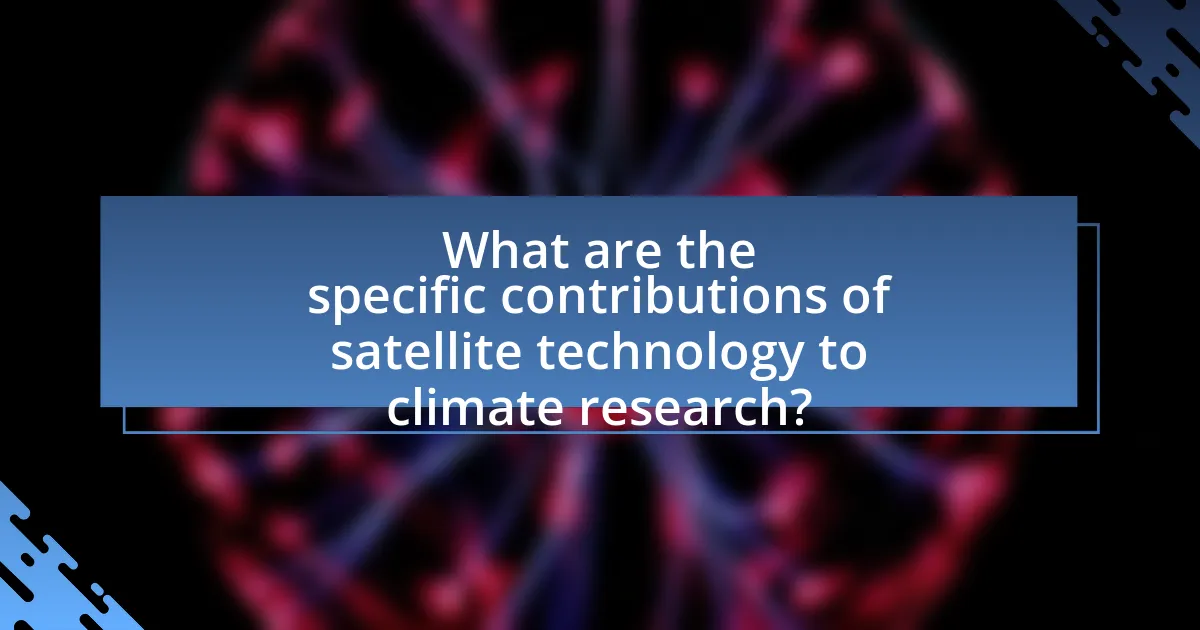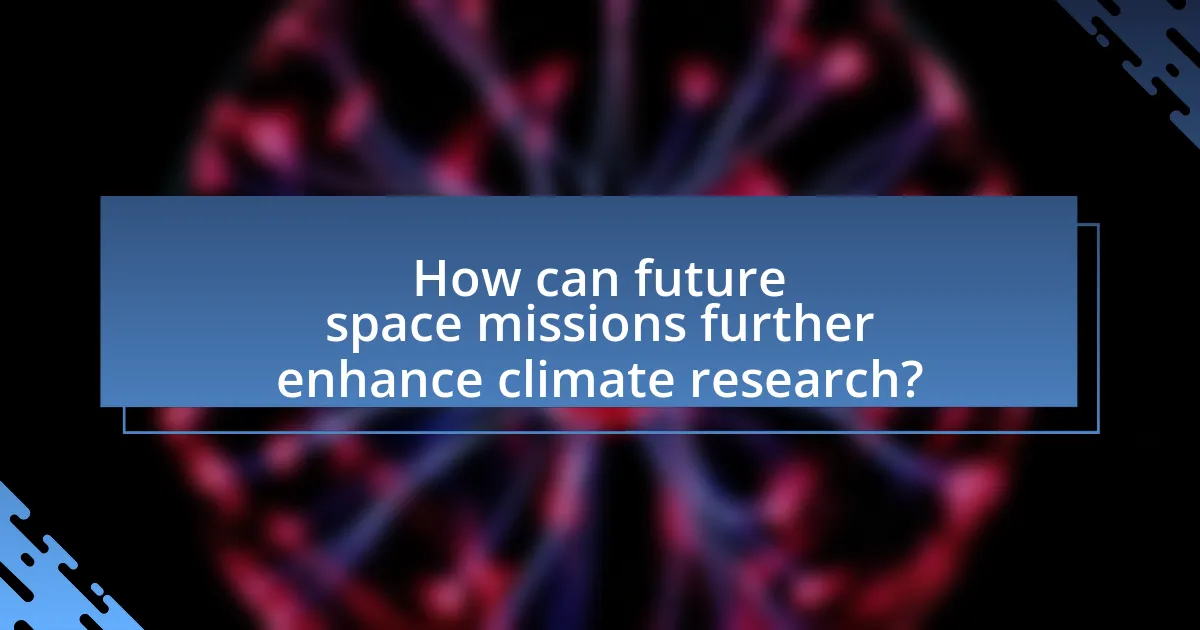The article examines the significant impact of space exploration on Earth’s climate research, highlighting how satellite technology enhances data collection and analysis of climate patterns. It discusses the role of various satellite missions, such as NASA’s Earth Observing System and the European Space Agency’s Copernicus program, in monitoring atmospheric conditions, greenhouse gas emissions, and land-use changes. The article also addresses the technological advancements in remote sensing, the importance of international collaborations, and the challenges faced in integrating satellite data into climate models. Overall, it emphasizes the critical contributions of space-based observations to understanding climate change and informing policy decisions.

What is the Impact of Space Exploration on Earth’s Climate Research?
Space exploration significantly enhances Earth’s climate research by providing critical data through satellite technology. Satellites equipped with advanced sensors monitor atmospheric conditions, greenhouse gas concentrations, and land-use changes, enabling scientists to analyze climate patterns and trends. For instance, NASA’s Earth Observing System satellites have been instrumental in tracking global temperature changes and ice melt, contributing to a better understanding of climate change impacts. Additionally, missions like the European Space Agency’s Copernicus program offer comprehensive data on air quality and land cover, which are essential for climate modeling and policy-making. This integration of space-based observations into climate science has led to improved predictive models and more informed decisions regarding climate action.
How has space exploration contributed to our understanding of climate change?
Space exploration has significantly enhanced our understanding of climate change by providing comprehensive data on Earth’s atmosphere, land, and oceans. Satellites, such as NASA’s Terra and Aqua, have been instrumental in monitoring global temperatures, greenhouse gas concentrations, and deforestation rates. For instance, the European Space Agency’s Copernicus program offers detailed observations of land surface changes, which are crucial for assessing the impacts of climate change on ecosystems. Additionally, satellite altimetry has enabled precise measurements of sea-level rise, revealing that global sea levels have risen approximately 3.3 millimeters per year since 1993. This data is vital for predicting future climate scenarios and informing policy decisions.
What specific technologies from space exploration are used in climate research?
Satellite remote sensing technologies are specific tools from space exploration used in climate research. These satellites, such as NASA’s MODIS (Moderate Resolution Imaging Spectroradiometer) and ESA’s Sentinel-5P, provide critical data on atmospheric composition, land surface temperatures, and ocean conditions. For instance, MODIS captures data that helps track deforestation and monitor changes in land use, while Sentinel-5P measures air quality and greenhouse gas concentrations. This data is essential for understanding climate change impacts and informing policy decisions.
How do satellite observations enhance climate data accuracy?
Satellite observations enhance climate data accuracy by providing comprehensive, real-time measurements of atmospheric and surface conditions across the globe. These observations enable scientists to collect data on temperature, humidity, cloud cover, and greenhouse gas concentrations with high spatial and temporal resolution. For instance, NASA’s MODIS (Moderate Resolution Imaging Spectroradiometer) satellite captures data that helps improve climate models by offering consistent measurements over time, which are crucial for understanding long-term climate trends. Additionally, satellite data allows for the monitoring of remote areas that are difficult to access, ensuring a more complete dataset. This extensive coverage and precision significantly reduce uncertainties in climate predictions, thereby enhancing the overall reliability of climate data.
Why is space-based data crucial for climate modeling?
Space-based data is crucial for climate modeling because it provides comprehensive, global observations of Earth’s climate systems. Satellites collect data on atmospheric temperatures, greenhouse gas concentrations, sea level rise, and land use changes, which are essential for understanding climate dynamics. For instance, NASA’s Earth Observing System satellites have been instrumental in tracking changes in ice cover and sea surface temperatures, enabling accurate predictions of climate trends. This data is vital for developing reliable climate models that inform policy decisions and adaptation strategies.
What role do satellites play in monitoring greenhouse gas emissions?
Satellites play a crucial role in monitoring greenhouse gas emissions by providing comprehensive, real-time data on atmospheric concentrations of gases such as carbon dioxide and methane. These satellites utilize advanced sensors and imaging technology to detect and quantify greenhouse gases from space, enabling scientists to track emission sources and trends over time. For instance, NASA’s Orbiting Carbon Observatory-2 (OCO-2) has been instrumental in measuring carbon dioxide levels globally, offering insights into human activities and natural processes that contribute to emissions. This satellite data is essential for informing climate policies and understanding the effectiveness of emission reduction strategies.
How does remote sensing improve climate predictions?
Remote sensing enhances climate predictions by providing comprehensive, real-time data on atmospheric and surface conditions. This technology utilizes satellites equipped with sensors to collect information on temperature, humidity, vegetation cover, and ocean currents, which are critical for understanding climate patterns. For instance, NASA’s MODIS (Moderate Resolution Imaging Spectroradiometer) satellite has been instrumental in monitoring land surface temperatures and vegetation changes, contributing to more accurate climate models. By integrating this data into predictive models, scientists can improve the accuracy of climate forecasts, enabling better preparedness for climate-related events.
What are the historical milestones in space exploration related to climate research?
The historical milestones in space exploration related to climate research include the launch of the first Earth-observing satellite, TIROS-1, in 1960, which provided critical data on weather patterns. In 1978, the launch of the Nimbus-7 satellite marked a significant advancement by measuring atmospheric temperature and humidity, contributing to climate modeling. The 1999 launch of the Terra satellite further enhanced climate research by providing comprehensive data on land, ocean, and atmospheric interactions. In 2002, the launch of the Aura satellite focused on atmospheric composition, monitoring greenhouse gases and ozone levels. These milestones collectively advanced our understanding of climate change and its impacts on Earth.
Which missions have significantly advanced our climate knowledge?
NASA’s Earth Observing System (EOS) missions have significantly advanced our climate knowledge. The EOS satellites, including Terra and Aqua, have provided critical data on Earth’s climate systems, such as temperature, precipitation, and atmospheric composition. For instance, the Terra satellite, launched in 1999, has been instrumental in monitoring land surface changes and carbon cycle dynamics, while Aqua, launched in 2002, has focused on water cycle processes. These missions have collectively contributed to a better understanding of climate change impacts, evidenced by the comprehensive datasets they have generated, which are utilized in climate modeling and policy-making.
How have international collaborations in space exploration impacted climate research?
International collaborations in space exploration have significantly enhanced climate research by facilitating the sharing of data, technology, and expertise across nations. For instance, the European Space Agency’s Copernicus program, which involves multiple countries, provides comprehensive satellite data on land, ocean, and atmospheric conditions, enabling more accurate climate modeling and monitoring. Additionally, NASA’s collaboration with international partners on missions like the Global Precipitation Measurement (GPM) has improved our understanding of precipitation patterns and their effects on climate systems. These partnerships not only increase the volume and quality of climate data available but also foster innovative approaches to tackling climate change, as seen in joint research initiatives that leverage diverse scientific perspectives and methodologies.
How does space exploration influence climate policy and action?
Space exploration significantly influences climate policy and action by providing critical data on Earth’s climate systems through satellite observations. Satellites monitor greenhouse gas emissions, track deforestation, and assess changes in ice cover, which are essential for informing policymakers about climate change impacts. For instance, NASA’s Earth Observing System satellites have contributed to the understanding of carbon dioxide levels, enabling countries to set more accurate emissions reduction targets under international agreements like the Paris Accord. This data-driven approach helps governments formulate effective climate strategies and allocate resources efficiently to combat climate change.
What challenges does space exploration face in supporting climate research?
Space exploration faces significant challenges in supporting climate research, primarily due to high costs, technological limitations, and data integration issues. The financial burden of launching and maintaining satellites can restrict the number of missions dedicated to climate monitoring. For instance, the cost of a single satellite mission can exceed hundreds of millions of dollars, limiting the frequency and scope of climate-related data collection. Additionally, technological limitations can hinder the development of instruments capable of accurately measuring climate variables from space, such as greenhouse gas concentrations and surface temperatures. Furthermore, integrating data from various space missions poses challenges, as differing methodologies and calibration standards can lead to inconsistencies in climate models. These factors collectively impede the effectiveness of space exploration in enhancing our understanding of climate change.

What are the specific contributions of satellite technology to climate research?
Satellite technology significantly contributes to climate research by providing comprehensive data on atmospheric conditions, land use, and oceanic changes. Satellites equipped with remote sensing instruments monitor greenhouse gas concentrations, track deforestation, and assess sea level rise, enabling scientists to analyze climate patterns and trends over time. For instance, NASA’s Atmospheric Infrared Sounder (AIRS) measures carbon dioxide levels in the atmosphere, while the European Space Agency’s Sentinel satellites provide critical data on land cover changes and ice sheet dynamics. These precise measurements are essential for validating climate models and informing policy decisions aimed at mitigating climate change impacts.
How do different types of satellites aid in climate monitoring?
Different types of satellites aid in climate monitoring by providing critical data on atmospheric conditions, land use, and ocean temperatures. For instance, polar-orbiting satellites, such as NASA’s Terra and Aqua, collect data on surface temperatures, vegetation, and ice cover, which are essential for understanding climate change impacts. Geostationary satellites, like the GOES series, continuously monitor weather patterns and storm systems, offering real-time data that helps predict climate-related events. Additionally, specialized satellites, such as the European Space Agency’s Sentinel-1, utilize radar technology to measure land subsidence and deforestation, contributing to a comprehensive understanding of climate dynamics. These satellite systems collectively enhance climate models and inform policy decisions, demonstrating their vital role in climate research.
What are the advantages of using polar orbiting satellites?
Polar orbiting satellites provide several advantages, primarily their ability to offer comprehensive global coverage and high-resolution data. These satellites travel in orbits that pass over the Earth’s poles, allowing them to observe the entire surface of the Earth over time as the planet rotates beneath them. This capability is crucial for climate research, as it enables consistent monitoring of atmospheric conditions, land use changes, and ocean temperatures across different regions.
Additionally, polar orbiting satellites can collect data at various altitudes and angles, enhancing the accuracy of climate models. For instance, the National Oceanic and Atmospheric Administration (NOAA) utilizes polar orbiting satellites to gather critical data for weather forecasting and climate monitoring, which has proven essential for understanding long-term climate trends and variability. The combination of global coverage and high-resolution data makes polar orbiting satellites indispensable tools in the field of climate research.
How do geostationary satellites enhance weather forecasting?
Geostationary satellites enhance weather forecasting by providing continuous, real-time monitoring of atmospheric conditions over specific regions. These satellites orbit the Earth at the same rotational speed as the planet, allowing them to maintain a fixed position relative to the surface. This capability enables meteorologists to capture high-frequency images and data on cloud cover, temperature, humidity, and storm development, which are crucial for accurate weather predictions. For instance, the Geostationary Operational Environmental Satellites (GOES) program has significantly improved the ability to track severe weather events, such as hurricanes and thunderstorms, by offering updates every few minutes. This timely data collection leads to better forecasting accuracy and more effective early warning systems, ultimately saving lives and property.
What data do satellites provide that ground-based observations cannot?
Satellites provide comprehensive global data on atmospheric conditions, land use, and ocean temperatures that ground-based observations cannot achieve due to their limited spatial coverage. For instance, satellites can monitor large-scale phenomena such as hurricanes, wildfires, and deforestation in real-time across vast areas, which ground stations, often localized, cannot capture effectively. Additionally, satellites can measure variables like sea surface temperatures and greenhouse gas concentrations from a global perspective, enabling a more complete understanding of climate patterns and changes. This capability is supported by data from NASA’s MODIS (Moderate Resolution Imaging Spectroradiometer), which collects information over the entire Earth’s surface daily, illustrating the unique advantage of satellite observations in climate research.
How does satellite data improve our understanding of ocean temperatures?
Satellite data enhances our understanding of ocean temperatures by providing comprehensive, real-time measurements across vast areas of the ocean. This technology enables scientists to monitor sea surface temperatures with high precision, capturing variations that are critical for climate modeling and weather forecasting. For instance, satellite sensors like the Moderate Resolution Imaging Spectroradiometer (MODIS) can detect temperature changes as small as 0.1 degrees Celsius, allowing for detailed analysis of ocean heat content and its impact on global climate patterns. Additionally, satellite data facilitates the observation of long-term trends in ocean temperatures, which is essential for understanding phenomena such as El Niño and climate change.
What insights do satellites offer regarding land use changes?
Satellites provide critical insights into land use changes by offering high-resolution imagery and data that track alterations in land cover over time. These observations enable the monitoring of urban expansion, deforestation, agricultural practices, and natural disasters. For instance, the Landsat program has been instrumental in documenting land use changes since the 1970s, revealing trends such as a 20% increase in urban areas globally from 1990 to 2015. Additionally, satellite data can assess the impact of land use on carbon emissions, with studies indicating that deforestation contributes to approximately 10% of global greenhouse gas emissions. This data is essential for policymakers and researchers to understand environmental impacts and develop sustainable land management strategies.

How can future space missions further enhance climate research?
Future space missions can enhance climate research by providing advanced satellite technology that improves data collection on atmospheric conditions, land use, and oceanic changes. These missions, such as NASA’s upcoming Earth Observing System missions, will utilize high-resolution sensors to monitor greenhouse gas emissions and track climate patterns with unprecedented accuracy. For instance, the Sentinel satellites from the European Space Agency have already demonstrated the ability to measure carbon dioxide levels globally, which is crucial for understanding climate change dynamics. By deploying more sophisticated instruments and expanding the coverage of Earth observation satellites, future missions will enable scientists to analyze climate data in real-time, leading to more effective climate models and informed policy decisions.
What upcoming missions are expected to impact climate science?
Upcoming missions expected to impact climate science include NASA’s Earth System Observatory, scheduled for launch in the mid-2020s, which aims to provide comprehensive data on Earth’s climate systems. This mission will utilize advanced satellite technology to monitor greenhouse gases, aerosols, and land surface changes, enhancing our understanding of climate dynamics. Additionally, the European Space Agency’s Copernicus Sentinel-6 mission, launched in late 2020, continues to provide critical data on sea-level rise and ocean circulation, which are vital for climate modeling. These missions are designed to deliver high-resolution observations that will significantly improve climate predictions and inform policy decisions.
How will new technologies improve data collection from space?
New technologies will enhance data collection from space by increasing the accuracy, speed, and volume of data gathered. Advanced sensors, such as hyperspectral imaging and synthetic aperture radar, enable detailed observations of Earth’s surface and atmosphere, allowing for precise monitoring of climate variables. For instance, NASA’s Earth Observing System satellites utilize these technologies to collect data on temperature, vegetation, and atmospheric gases, significantly improving climate models. Additionally, the deployment of small satellites, or CubeSats, facilitates more frequent data collection at lower costs, enabling continuous monitoring of environmental changes. This technological evolution is crucial for timely responses to climate change and supports informed decision-making in climate research.
What role will international partnerships play in future climate missions?
International partnerships will be crucial in future climate missions by facilitating resource sharing, knowledge exchange, and collaborative research efforts. These partnerships enable countries to combine their technological capabilities and scientific expertise, leading to more comprehensive climate data collection and analysis. For instance, the European Space Agency’s collaboration with NASA on the Earth Observing System has resulted in enhanced satellite data that improves climate modeling and monitoring. Such international cooperation not only accelerates innovation but also ensures that diverse perspectives and approaches are integrated into climate solutions, ultimately strengthening global responses to climate change challenges.
What best practices can researchers adopt to maximize the benefits of space exploration in climate research?
Researchers can maximize the benefits of space exploration in climate research by integrating satellite data with ground-based observations. This approach enhances the accuracy of climate models and provides comprehensive insights into atmospheric and environmental changes. For instance, NASA’s Earth Observing System satellites collect data on temperature, humidity, and greenhouse gas concentrations, which, when combined with local measurements, improve predictive capabilities. Additionally, fostering interdisciplinary collaboration among scientists, engineers, and policymakers can lead to innovative solutions and effective communication of findings. Engaging in public outreach and education about the significance of space-derived climate data can also increase support for funding and research initiatives.

